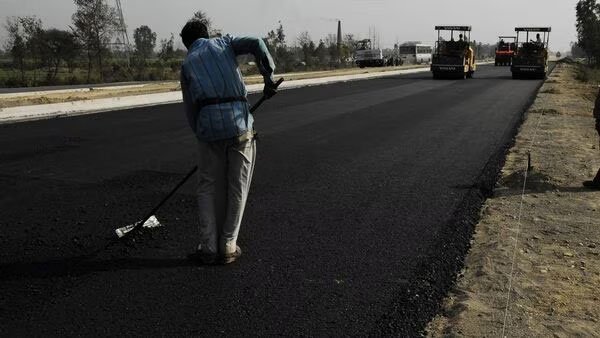With the 2024 national elections on the horizon, India’s ambition to expand its road network within this fiscal year hangs by a thread. Will the country manage to bridge the gap between targets and achievements in time?
India’s road construction progress has been sluggish, with only 38% of the planned roads built in the first eight months of the fiscal year, despite having spent two-thirds of the allocated funds, according to official data.
The government earmarked over ₹2.58 trillion to construct 13,800 km of highways this year. However, the Union ministry of road transport and highways has only managed to build 5,248 km as of November, after expending around ₹1.7 trillion. The National Highways Authority of India (NHAI), entrusted with the development and maintenance of national highways, received a substantial portion of the allocated budget.
Given this slow pace, it is unlikely that India will achieve its road-addition target for the fiscal year, especially with the 2024 national elections on the horizon. Land acquisition issues continue to plague large infrastructure projects in the country, while the government’s indecision on the project-delivery model has delayed contract awards for road projects.
Despite the current year’s highway construction exceeding the previous year’s 4,766 km, an anonymous source noted that it might not be enough to meet the overall construction target of over 10,000 km by 2023-24. The decline in road project awards from 5,382 km to 2,815 km between April and November suggests a diminishing pipeline for future projects, which could have lasting effects from 2024-25 onwards.
In the preceding years, India constructed 10,331 km of highways in 2022-23 and 10,457 km in the year prior.
The deceleration in highway project awards stems from various factors. Ashish Suman, partner at JSA Advocates and Solicitors, attributes this slowdown to protracted deliberations on the preferred project development model. The government’s inclination towards reviving the build-operate-transfer (BOT) model has contributed to delays in the award process. Additionally, cautiousness in granting projects without finalized land acquisition and permits, alongside delays in Bharatmala Phase I program awards, have created bottlenecks, impeding road development.
Bharatmala, a pivotal government highway initiative, faces significant delays due to sharp cost escalations, potentially affecting its timely completion by 2022. Despite inquiries, the ministry has not yet responded.
The government’s sustained emphasis on infrastructure development is evident through its substantial budgetary allocation of over ₹2.58 trillion for the road ministry this year. It ensures full funding for NHAI’s capital expenditure from its own budget to avert the high debt of road developers from hindering infrastructure growth.
Notably, recent data from the ministry indicates a deceleration in highway construction to a mere 774 km in November, averaging 26 km per day. The construction pace falls short of the requisite 50 km per day to accomplish the ambitious target of 10,000 km of highways. However, Crisil research director Aniket Dani contends that the increased construction pace of lanes justifies the heightened ministry expenditure.
Furthermore, an Icra report underscores a typical deceleration in highway awards preceding general elections, which aligns with the model code of conduct. This timing presents a challenge in achieving the 13,800 km target for 2023-24, as constructing over 50 km of highways in the last four months before elections could be arduous.











